Organised by Carl, G3PEM
As usual the Committee await with baited breath to see who produces an entry. We had 4 entries for the June Meeting, less than some years.
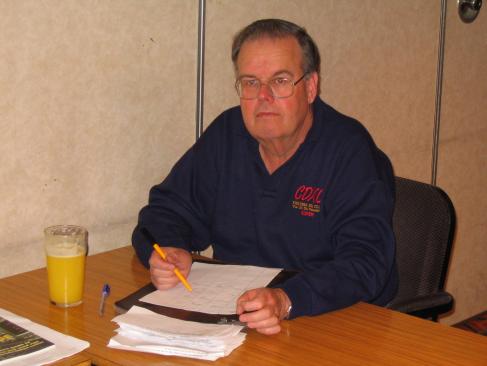
Carl, G3PEM, organiser for this Month's event.
Photos by John, G8DET
Carl started the evening off by explaining why he had to get a new Radio Shack. He then talked the audience through the selection process and the rational used; using overhead slides.
The new shack was laid out following mock-ups of where the rigs were to go in relationship with the computers. The old shack was used as the garden shed - the previous one hitting the bin.
Geoff, G7KLV then described how he built a Capitance & Inductance Bridge from Practical Electronics. It used a pulse width detection counter using a CMOS chip. It did work earlier on in the evening but refused to work when he had the floor!.
A comment from the audience indicated that more recent copies of the magazine had discussed this point and the choice of chip due to a variation in the threshold trigger level. It worked later & will prove to be a useful piece of equipment to have in the shack.
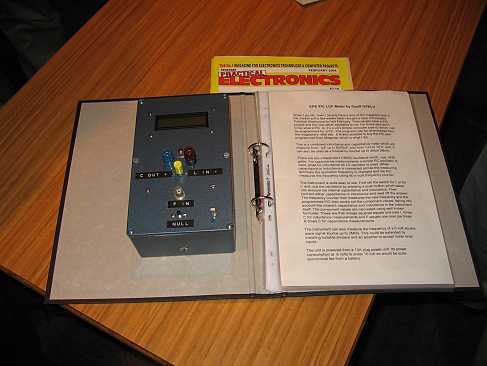
Geoff's Tester.
Anthony, M1FDE then showed a large digital Display Board with the comment "I did not build it". It was built for recording the lap times and details for model cars and was driven by a computer. Anthony did however design it.
He then took the audience through the many design stages that the version displayed had gone through - he did not use LCD displays due the high ambient light levels when on-site. It proved to be a very powerful display.

Anthony's Display.
Next to take the floor was Colin, G0TRM.
He informed the audience that he had built the equipment on display - but 50
years ago when he was an Apprentice for Marconi. As it had not been
used for a few years (????) he ran it up over a number of days using a
Variac to reform the many electrolyte capacitors - which it did.
Shutting his garage door caught the amplier and it smashed a couple of valves
which were replace this evening.
To demonstrate the audio quality he produced a traditional jazz source & it sounded very good. Sound engineering practice had been used this the cores of the mains transformer, Mains choke & output tranformer all being in a different plane to prevent interaction. It was using a pair of 6V6s in the push-pull output and was rated at 10 to 15 Watts.
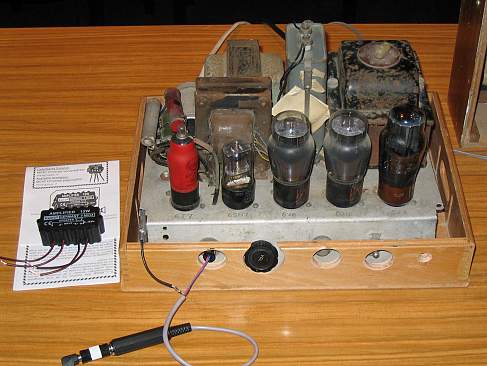
Colin's Audio Amplifier. Note the transistor module to the left of the amp which produces about the same sound level (but not the same lovely quality!).
The CARS audience were requested to state who should win & in the break-time the marks were counted. After a couple of late submissions the score was as follows:-
1st - Geoff, G7KLV.
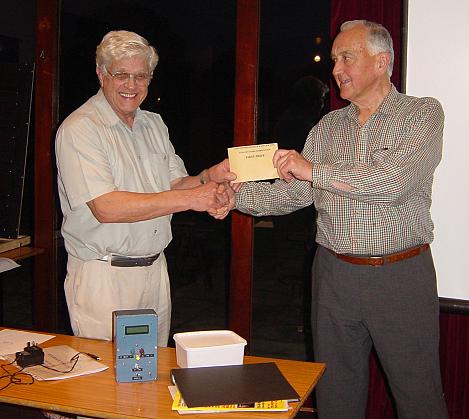
Geoff, G7KLV receiving the Winners Certificate from Club Vice President, Geoff Mills, G3EDM.
Photograph supplied by Anthony, M1FDE
2nd - Carl, G3PEM
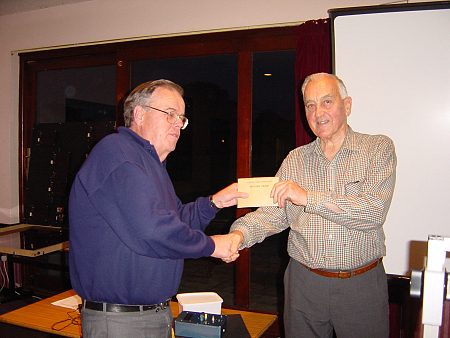
Carl, G3PEM receiving the 2nd Winners Certificate from Club Vice President, Geoff Mills, G3EDM.
Photograph supplied by Anthony, M1FDE
3rd - Anthony, M1FDE
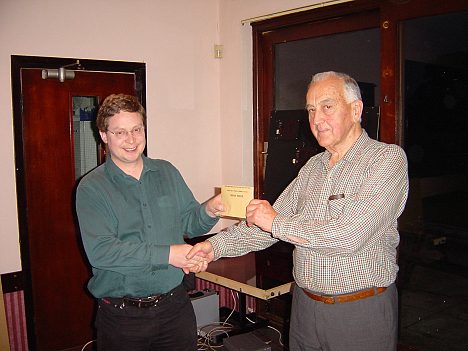
Anthony, M1FDE receiving the 3rd Winners Certificate from Club Vice President, Geoff Mills, G3EDM.
Photograph supplied by Anthony, M1FDE
Special Prize - Colin, G0TRM.
A demontration Contructor's Competition from yester-year was provided by John, G8DET. It was a 2 metre SSB Transceiver built in 1973 to a design by German Amateur, DC1HL and published in VHF Communications by Terry Bittan.
It featured a 5-6 Mhz VFO & a 9 Mhz IF using a German 8 pole Crystal Filter by KVG (XF9B) for beautiful audio quality. Its output being 1/2 Watt.
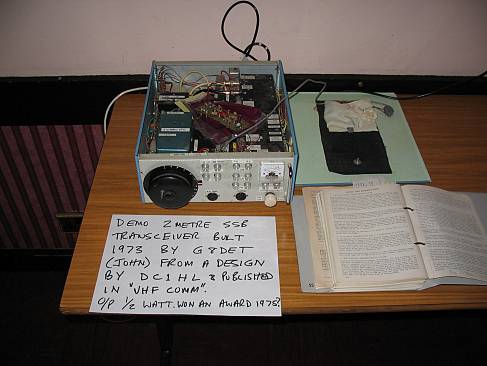
G8DET's 2 Metre Transceiver. It used to drive a 100 Watt RF Amplifier.
The Raffle provides many excellent Prizes and also makes money for the Club
Funds thanks to clever prizes being purchased by the Organisers and donations
by Members.
The June Meeting Organisers were Tony, G4YTG & Jean (Ex-G3UTC).
The many prizes can be seen on display on the Raffle table.

Raffle Organisers and their Prizes. Tony is holding a full size G5RV Aerial.
Thank you Carl for organising the evening.
May Meeting - DRM
By Simon Gosby, G8OVZ
Simon is a Project Manager, Transmission Services at the BBC World Service.
The first half of the talk covered what modulation methods are used now and what Digital Radio Mondiale (DRM) is and how it works.
DRM is the new digital transmission mode designed for Medium Wave and HF broadcasting which will eventually replace AM transmissions.
What is DRM?. DRM will provide FM-like-quality sound in a similar spectrum as AM (9 or 10kHz). It should improve reception with no real change of listening habits regarding skip, etc. Besides high quality sound it can also provide integrated data and text, similar to RDS on FM.

This is a picture of a Singapore Sender 103 which Simon talked about.

This is a typical aerial which the Sender, above, will feed.
I bet you would like this to use on the HF Bands!
After showing many pictures of 100 to 500kW Transmitters from around the World, Simon played examples of AM and then DRM received transmissions from a number of places. The received quality was quite noticeable. Fading was gone as was phase distortion.
A very high quality presentation thanks to PowerPoint and a professional speaker. Thank you Simon.
Click Here to download a well written explanation about DRM by Dick Brocks, G3WHR. It is in PDF Format and is 2 pages.
Click BACK on your Browser to get back to this page having looked at the write-up.
April Meeting - Amateur Radio Aerials
By Tony Gilbey, G4YTG
The evening started with a local young lad trespassing onto MASC property and throwing a drawer front through the outside fire doors of the meeting room. He was restrained by CARS Members until the Police handcuffed him and took him away.
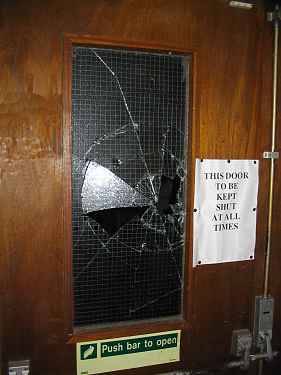
Photograph of the broken window outside the meeting room.
Donald Imber, G0VIS was sheduled to present a talk about Marine Radio but regretably had passed away.
Tony volunteered to present an aerial talk and was requested to build on the presentation given the previous month by Alan Boswell.
Tony compared the commercial with amateur aerials and the space they take up. Rugby, for example, was built of 12 masts 820 feet high while a amateur will have a much smaller space available.
He then said that there is no such thing as as aerial gain - if one puts 1 watt into an aerial - only one watt can come out. However, there is aerial directivity.
What do we as radio amateurs want from an aerial?.
We want to tune it, to radiate, to have space around it and ideally
for it to be high. It has been said "if it did not blow down last
winter - it was not high enough!".
Tony then described the "workings" of a number of well known aerials including the J-Pole, Slim-Jim, Ground Plane, Colinear, Inverted Vee, Trapped Aerials, Yagi, Multiband Windom, Loops, G5RV, Quad, Discone, Log Periodic and finally The Kite.
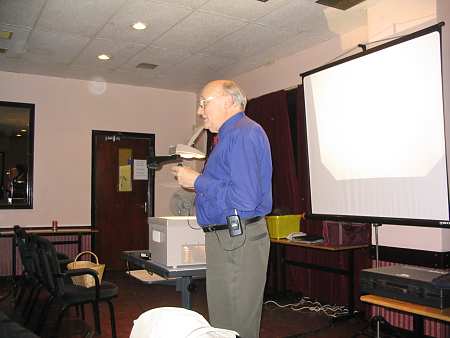
Tony, G4YTG talking to the audience. There was a large audience.
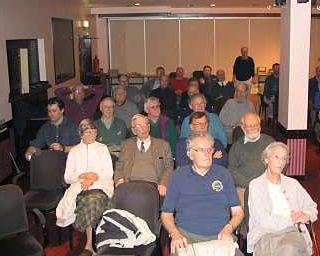
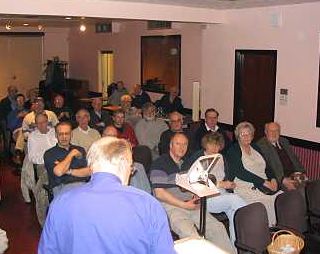
The audience as seen by Tony.

Tony, G4YTG holding his loop aerial.
Thank you Tony for such a good radio Amateur Radio Aerial presentation.
March Meeting - Antennas
By Alan Boswell, G3NOQ
Alan started by providing a number of basic facts and reminded the audience of electrical relationships. Then he went on to examine the requirements for a good efficient radiating aerial.
The next subject covered was vertical polarisation, used mainly by amateurs when mobile, MW & LW broadcasters. He mentioned that sea water was a good conductor which helped 27 MHz. Rhombics were examined.
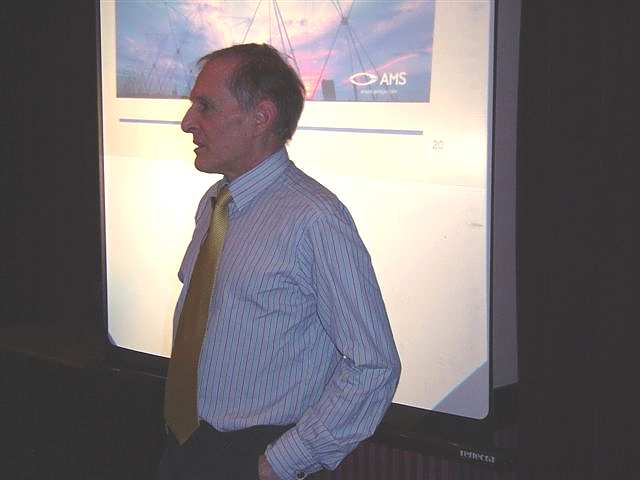
Alan Boswell, G3NOQ lecturing to CARS

Photograph of the Tetrahedral Aerial which Alan designed
Alan explained that this was a HF radar aerial and was about 6m high. It
was really a fattened vertical dipole fed between the tetras either side
of the nylon centre insulator, which causes a high impedance point at
the lower support end and an RF voltage max, thus requiring an insulator.
During Question Time he said it could be scaled down for amateur use.
A Mr Uda was given the credit for designing the aerials described later by Mr Yagi - credit is now usually given to the latter. He described how they worked.
A very comprehensive description of aerials - thank you Alan.
February Meeting - Amateur Power Measurement
Dave Penny, G3PEN
Fortunately, the very cold and snowy weather of the previous week
had been replaced by wind and rain, so it did not disrupt travel too much.
Chris, G0IPU Chaired the Meeting.
The technical problems of measurement at RF, the methods available and the accuracy of results, were looked at, as will be the availability of suitable commercial and "surplus" measuring equipments, and the scope for home-brewing and calibration.
Dave produced dozens of overhead projector slides to illustrate his topic.
A display of about 20 typical instruments was presented, and a short demonstration of measurement with different meters was made.
Finally, a brief look at RF attenuators, especially home-brewed high-power versions, and their use for both transmitting and receiving power and signal-level tests, finished the session.
Thank you Dave for an interesting "Amateur subject".